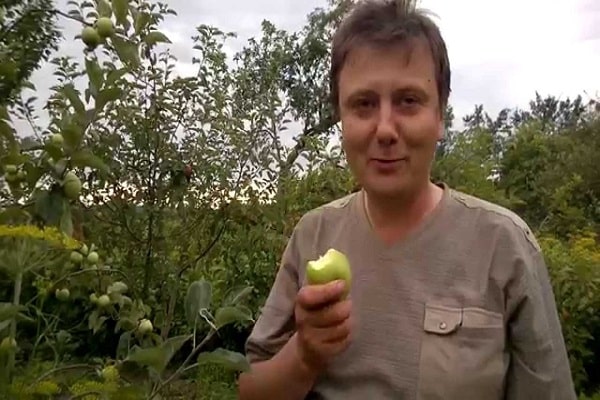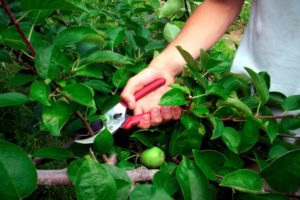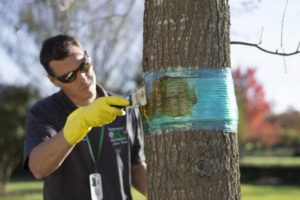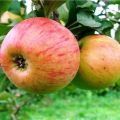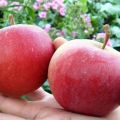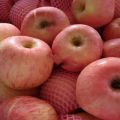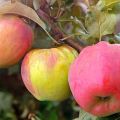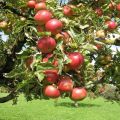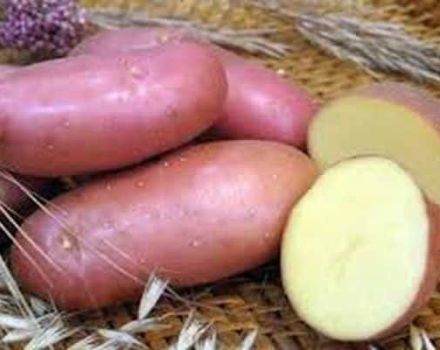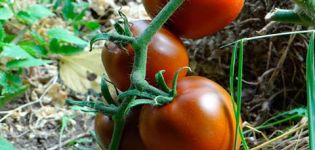Description and characteristics of the Candy apple variety, cultivation in the regions and features of care
Yablonya Candy, like many other sweet apples for cultivation in temperate latitudes, was bred by biologist-breeder S.I. Isaeva. The fruit of Korobovka's cross-pollination with the pollen of the Papirovka variety is called a candy apple, and in some regions the nickname “apple-caramel” is firmly stuck behind the tree. The improved Korobovka received a more juicy pulp.
Variety characteristics
Areas favorable for the cultivation of the Candy variety have not been selected, it can be grown in almost any conditions; feeding, pruning, planting will differ by 1-2 weeks from the recommended average period.
The apple tree stands out for its aesthetic beauty during flowering and fruiting. Apples are even, about the same diameter and weight, their average weight is 120-130 g. Fruiting begins depending on the selected rootstock. For the 6th season, you can already get up to 50 kg of apples from a seedling. Every year the growth of fruits increases, an adult tree yields up to 100 kg.
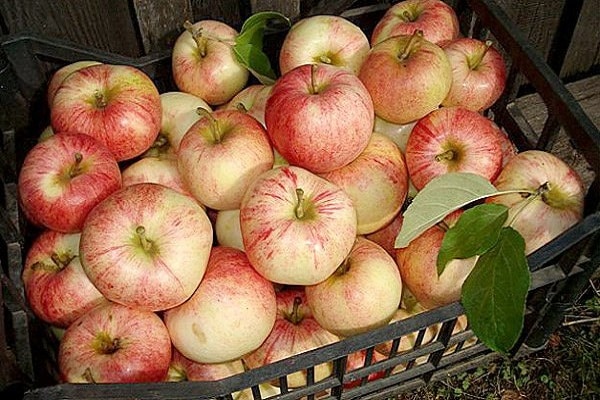
Despite the fact that Candy is positioned as a summer variety, mature fruits harvested from an apple tree can be stored for more than 2 months.
Taste qualities
Appreciation of apple lovers does not quite coincide with the opinion of professionals, who rated the taste by only 4.2 points. It is rather difficult to say exactly what the caramel apple fruits taste like. According to the description of gardeners from different regions, it has a taste of pineapple, honey, bananas, pear notes.
Low temperature resistance
High frost resistance went to erase Candy from the varieties that participated in its breeding. Just like its progenitors, Candy is well adapted to the conditions of the Moscow region, the North-Western regions, and the Leningrad region. The Pskov region, Belarus and Ukraine are the best climate in which garden apple trees will not get frostbite in winter.
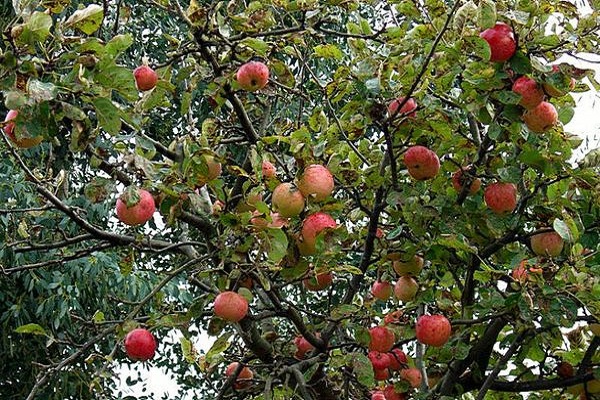
Positive and negative ratings
Excellent fruit taste, quick crown recovery after pruning and frostbite, adaptability to different soils and weather conditions are the best qualities. The disadvantages of the Candy variety are the susceptibility to scab disease under prolonged cool, wet weather conditions, and extremely weak resistance to damage during transportation.
Wasps love these fragrant apples. Which negatively affects the presentation of the fruit.
Crown parameters
The height of the Candy variety is laid by grafting it to a certain type of rootstock. The maximum trunk height is 5 m, while the crown diameter is 2.5-3 m. The tier of the crown is set when it is properly cut.Longer formation begins in the second spring after planting due to thinning and strict tracking of the length of skeletal branches.
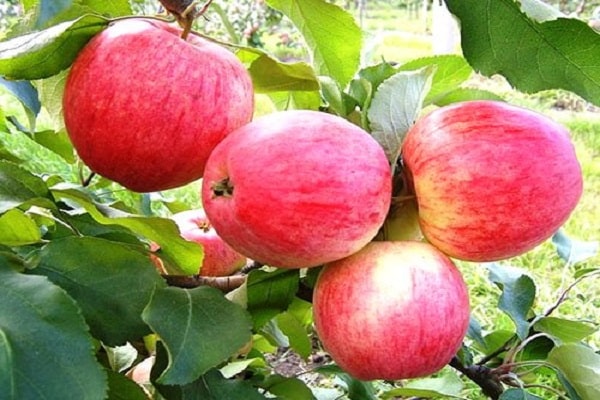
Self-fertility
The variety is self-fertile, but its yield increases sharply if varieties grow in the immediate vicinity, whose flowering coincides in terms with Candy.
Pollinators
The best pollinating varieties for Candy in Russia and Belarus are:
- Anise Pink-striped;
- Bellefleur-Kitayka;
- Malt Bagaevsky;
- Melba;
- Folding;
- Glory to the Winners;
- Stark John Grimes;
- Yandykovskoe;
- Belevoe.

Bloom
Flowering occurs in mid - late May, which largely depends on the onset of stable positive temperatures.
Fruiting period
Fruit ripening begins a month before the apple Savior, which is extremely rare in the central part of Russia.
Harvesting
Harvesting must be done carefully, removing the apples from the branches and carefully placing them in a container for storage. Havea fallen apple can be stored for no more than 3 days, it must be processed until it becomes soft and brown inside from the resulting injury.
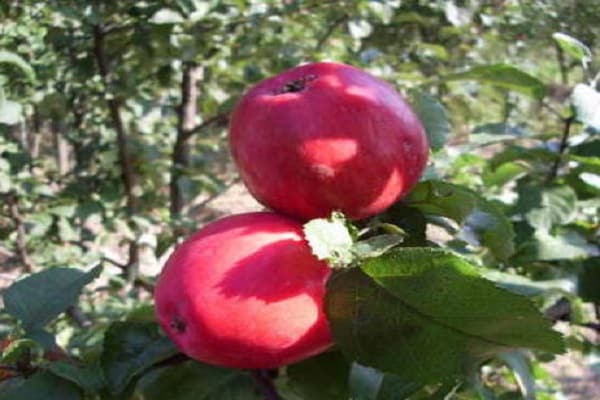
Existing subspecies
Summer apple tree Candy is more resistant to scab, the description of its leaves is very similar to Korobovka, they are just as tough to the touch. Candy is similar to its ancestor in terms of picking apples, only the pulp of the fruit is more tender and juicy.
Ranet Candy
This variety is not recorded either in the register of fruit trees, or in the descriptions of amateur breeders. Apparently, someone used the old Raneta tree to grow the Candy Bar. But it looks more like a marketing ploy when distributing seedlings that do not meet all the standards of the Candy variety.
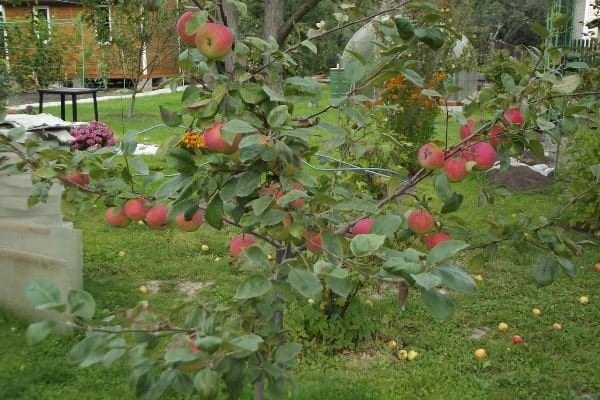
Candy-2
Apple-tree Candy-2 is an improved version of the main variety in terms of transportability and a crown more convenient for care and collection of fruits.
Candy summer
This is a delusion, this kind does not exist. Simply Candy, ripening well before August 19, the traditional harvest date for most apple varieties. The seller who assigns such a name includes inappropriate advertising.
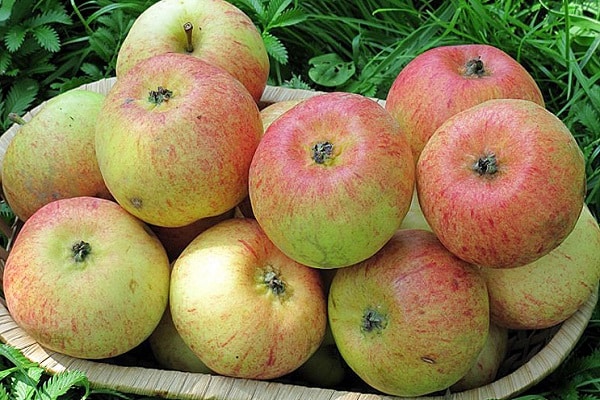
Tree care
Spraying with Fluazinam before the leaves start to peck is one of the most reliable ways to protect the tree from scab. The autumn mulching of the near-trunk zone, above the roots of the apple tree and the winter increase in the snowdrift near the trunk, help the tree to overwinter in a comfortable microclimate, which will affect the size and quality of the crop.
Fertilizing the soil
The first stage of tree feeding is done during planting, when the enriched soil is placed directly into the planting hole. In spring, traditionally dry fertilizers are scattered before irrigation on the soil loosened above the roots. With watering, nitrogen fertilizer is applied before flowering and the period of ovary formation, it is necessary so that the entire crop ripens on the branches.
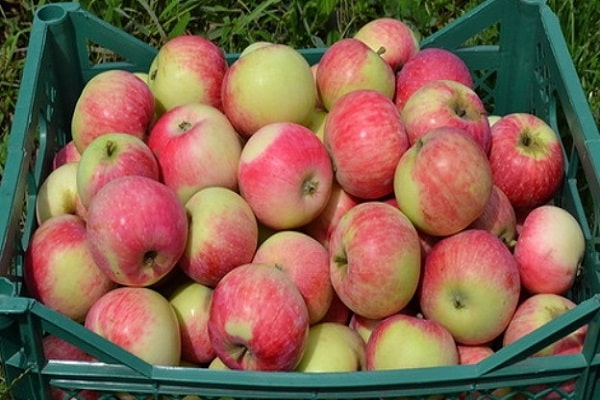
Irrigation
Watering when applying root dressings and after distributing foliar is mandatory, as well as when planting a seedling. To water or not water the apple tree in the process of ripening apples, you will have to decide on your own, based on the moisture of the soil. The abundance of watering depends on what air temperatures are.
Attention! Plants are never watered during the daytime when the sun is at its zenith. Watering is done early in the morning or late in the evening, when the foliage does not get sunburn.
Pruning for sanitary purposes
For sanitary purposes, pruning can be carried out at any time of the year. If this is due to the breakage of branches or infection of the tree, then cut off the affected areas and destroy them in a fire immediately. Thinning and crown formation is carried out in late autumn or early spring, while the tree juices flow slowly.
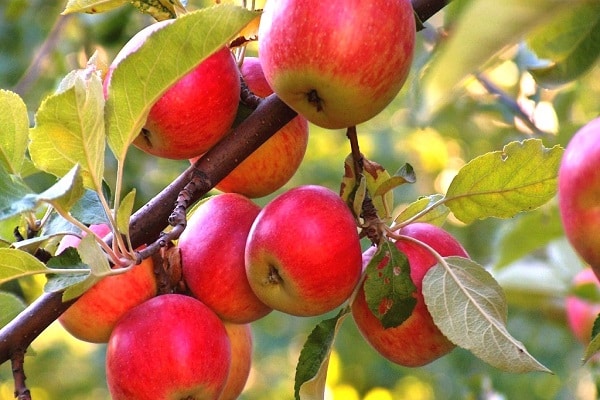
Whitewashing the trunk
The trunk is covered with lime mortar both in spring and autumn.Additives in the form of copper-containing components provide additional protection against fungal infections, and lime itself insulates the tree trunk and prevents insects from settling under the bark.
Basic rootstocks
Amateur gardeners, when self-grafting seedlings to old boles of fruit trees, do not particularly think about what result awaits them in 10-15 years. From nurseries, seedlings come with strict parameters that can be predicted even before planting.
Semi-dwarf
The candy apple tree on this rootstock is more common in the southern regions. It does not tolerate a cold climate as firmly as a seed one.
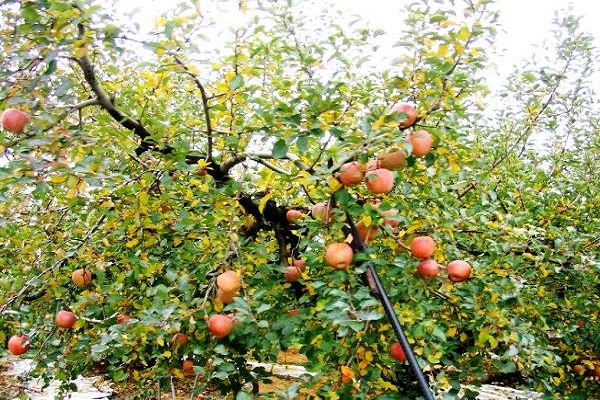
Dwarf
The height of the trunk barely reaches 170 cm, while the weight of each fruit is almost 200 g. In the second season, up to 35 kg of apples can be obtained from this small tree.
Candy columnar
Columnar apple trees of the Candy variety have not been registered. The species corresponding to apple trees on such rootstocks is given by dwarf and semi-dwarf stems.
Disembarkation dates
Depending on the climate of the region in which the apple tree is planted, the exact dates of planting are determined.
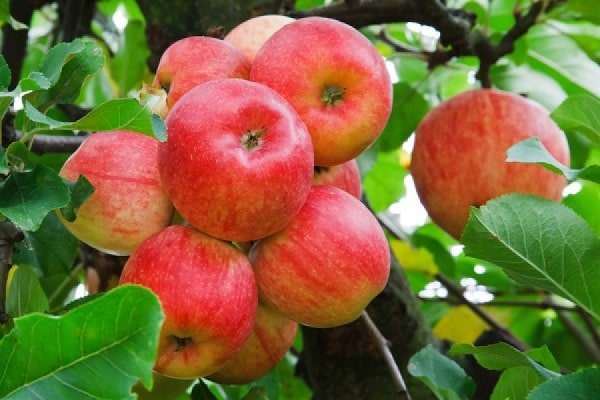
Autumn landing
The period during which the apple tree should be in the ground in a new place is limited by the framework when the average daily air temperature drops below +10 ° C, but frost has not yet come.
Spring landing
Saplings are planted after only a positive temperature outside day and night for more than 10 days. It is necessary to have time to plant a tree before the buds on other trees begin to swell and open intensively.
Growing trees in different climatic zones
In addition to the timing of planting, pruning, dressing, in each climatic zone for the Candy variety of apple trees, there are other features.
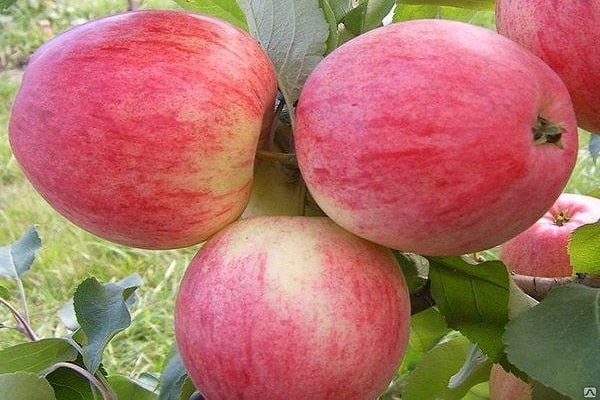
Moscow suburbs
For stable fruiting, the plant requires a lot of sunlight, this must be taken into account when choosing a planting site. There should be no tall trees, walls or high monolithic fences near the seedling. When planting, it is necessary to lay a 10-20 cm drainage layer in the hole.
Primorye
Planting in the Primorsky Territory is carried out in the spring, which involves preparing the hole in about six months - from autumn. Given the characteristics of the soil, it must be flavored with compost, saltpeter, superphosphate, nitroammophos. This is based on the fact that through light soils mineral additives carry away melt water. During heavy rains, which is not uncommon in the Primorsky Territory, excess moisture must be removed from the trunk, for which drainage grooves are laid.
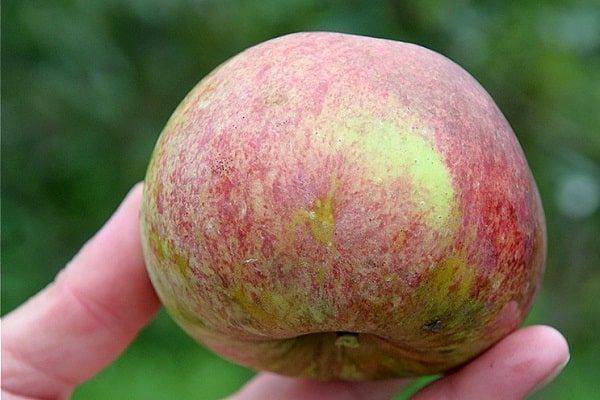
Ural
Inhomogeneous soils in the Urals, some of them are too loose, which requires constant replenishment of nutrients in the soil, the other part does not allow water and air to pass in the proper amount to the roots. As a result of the fact that water is retained on the surface, a favorable atmosphere is formed for pathogenic microflora, this provokes diseases.
Such soil must be loosened, introducing sand, ash, peat into it during digging. Ash reduces the acidity of the soil, which is also good for fruit trees.
Siberia
Although the Candy apple tree is frost-resistant, in Siberia, to protect it in winter, heaters are used for the lower part of the trunk - spruce branches of coniferous trees, hay, polyethylene or roofing material... An enhanced mulching of the near-trunk space is mandatory, and during digging, organic matter is introduced into the soil - manure or humus.

Northwest region
Loamy and sandy soils, peat bogs are the main soils of the northwestern regions. They have a drawback - they are not rich in all the elements necessary for fertility. Systematic feeding with organic and inorganic complex fertilizers is a necessity.
